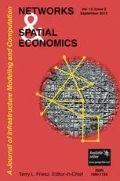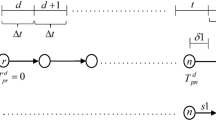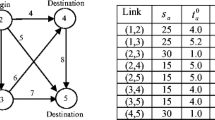Abstract
The doubly constrained entropy distribution/assignment (DEDA) problem that combines a gravity-based trip distribution (TD) problem and a traffic assignment (TA) problem has long been formulated as an optimization model and solved by two solution algorithms, i.e., partial- and full-linearization solution algorithms. As an alternative, this research first treats the DEDA problem by the augmented Lagrangian dual (ALD) method as the singly constrained entropy distribution/assignment (SEDA) problem, which in turn is addressed, via a tactical supernetwork representation, as an “extended” 1-origin-to-1-destination TA problem. A quick-precision TA solution algorithm, − called TAPAS (Traffic Assignment by Paired Alternative Segments), − is then adopted for solutions. The proposed approach is demonstrated with a numerical example for the correctness of the result, using Lingo 11 solver and the partial linearization solution (PLS) algorithm. Moreover, through the use of TAPAS in the innermost loop, the proposed approach also has the merit of generating unique path flow solution, which is very useful in route guidance under the intelligent transportation systems environment, among other academic applications. In addition, the proposed approach can be easily applied, or with minor modification at most, to various combined models in travel demand forecasting.



Similar content being viewed by others
Notes
Though not necessary, and only for extra discussion, Eq. (2c) may be rewritten in a manner similar to the stochastic extension of Wardrop’s first principle as follows:
$$ \ln {h}_r-{\displaystyle {\sum}_{r\supseteq a}{\beta}_a}\left\{\begin{array}{cc}\hfill ={\gamma}_{pq}\hfill & \hfill if\ {h}_r>\varepsilon \hfill \\ {}\hfill \ge {\gamma}_{pq}\hfill & \hfill if\ 0\le {h}_r\le \varepsilon \hfill \end{array}\right.\kern1.25em \forall r\in {R}_{pq},p,q $$(2d)where ε represents a very small number close to zero but is meaningful with respect to ln ε. Equation (2d) may be interpreted as: at equilibrium, for each O-D pair (p,q), the perceived cost \( \left( \ln {h}_r-{\displaystyle {\sum}_{r\in {R}_{pq}:r\supseteq a}{\beta}_a}\right) \) for any used route r, i.e., h r > ε ≈ 0, must be equal to the minimum perceived route cost γ pq . Note that Eq. (2d) must be used with extreme caution, because when h r = 0, then ln h r is negative infinity, and therefore the left hand side can never be greater or equal to the right hand side. This type of derivation can work only if the set of used routes is known in advance. However, this does not imply that all routes should be used, since under the user equilibrium (UE) assumption only least cost routes are used. In Bar-Gera’s (2010) jargon: “…no route should remain unused, unless there is a good reason for it. A good reason is that using the route causes UE violation.”
Noteworthy is that the equilibrium conditions, i.e., Eq. (2d), derived for the DEDA problem have thus far never been seen in the literature and, further, the interpretation of Eq. (2d) as a stochastic extension of Wardrop’s first principle is also new to the transportation field.
Eq. (3c) can be deemed as an extension of a fixed demand problem. In the fixed demand traffic assignment problem, Eq. (3c) will reduce to Eq. (6) in Bar-Gera (2010, p. 1032). That is
$$ {h}_r\left(\boldsymbol{\upbeta} \right)={d}_{pq}\cdot \frac{ \exp \left({\displaystyle {\sum}_{a\subseteq r}{\beta}_a}\right)}{{\displaystyle {\sum}_{r^{\prime}\in {R}_{pq}^0} \exp \left({\displaystyle {\sum}_{a\subseteq {r}^{\prime }}{\beta}_a}\right)}}\kern1.25em \forall r\in {R}_{pq}^0;p\in {N}_o;q\in {N}_d(p) $$(3h)
References
Bar-Gera H (2010) Traffic assignment by paired alternative segments (TAPAS). Transp Res B 44:1022–1046
Bar-Gera H, Nie Y, Boyce D, Hu Y, Liu Y (2010) Consistent route flows and the condition of proportionality. Presented at the 90th Annual Meeting of the Transportation Research Board, Washington, D.C., USA
Boyce D (2007) Forecasting travel on congested urban transportation networks: review and prospects for network equilibrium models. Netw Spat Econ 7(2):99–128
Chen HK (1999) Dynamic travel choice models: a variational inequality approach. Springer, Berlin
Chen HK (2015) A heuristic solution algorithm for the combined model of the four travel choices with variable demand. Presented at 11th EASTS (Eastern Asia Society for Transportation Studies) Conference, 11–14 September, 2015, Cebu, Philippines
Chen HK (2016) A two-objective model formulation for the traffic assignment problem with entropy measure. Presented at Transportation Research Board (TRB) 95th Annual Meeting, Washington, D.C.
Chen HK, Chen YC (1999) Comparisons of the Frank-Wolfe and Evans methods for the doubly constrained entropy distribution/assignment problem. J East Asia Soc Transp Stud 3(1):261–276
Chen HK, Feng G (2000) Heuristics for the stochastic/dynamic user-optimal route choice problem. Eur J Oper Res 126(1):13–30
Chen HK, Hsueh CF (1998) A model and an algorithm for the dynamic user-optimal route choice problem. Transp Res B 32(3):219–234
Chen HK, Wang CY (1999) Dynamic capacitated user-optimal route choice problem. Transp Res Rec 1667:16–24
Dial RB (2006) A path-based user-equilibrium traffic assignment algorithm that obviates path storage and enumeration. Transp Res B 40:917–936
Evans SP (1976) Derivation and analysis of some models for combining trip distribution and assignment. Transp Res B 10(1):37–57
Florian M, Morosan CD (2014) On uniqueness and proportionality in multi-class equilibrium assignment. Transp Res B 70:173–185
Florian M, Constantin I, Florian D (2009) A new look at the projected gradient method. In: CD-ROM of the Transportation Research Board 2009 Annual Meeting
Gentile G (2009) Linear user cost equilibrium: a new algorithm for traffic assignment. Submitted to Transport Res B. http://citeseerx.ist.psu.edu/viewdoc/download?doi=10.1.1.157.1095&rep=rep1&type=pdf
Hasan MK, Dashti HM (2007) A multiclass simultaneous transportation equilibrium model. Netw Spat Econ 7(3):197–211
Ho HW, Wong SC, Loo BPY (2006) Combined distribution and assignment model for a continuum traffic equilibrium problem with multiple user classes. Transp Res B 40(8):633–650
Karoonsoontawong A, Lin DY (2015) Combined gravity model trip distribution and paired combinatorial logit stochastic user equilibrium problem. Netw Spat Econ. doi:10.1007/s11067-014-9279-x
Lam WHK, Huang HJ (2003) Combined activity/travel choice models: time-dependent and dynamic versions. Netw Spat Econ 3(3):323–347
Li Y, Waller ST, Ziliaskopoulos T (2003) A decomposition scheme for system optimal dynamic traffic assignment models. Netw Spat Econ 3(4):441–455
Lindo Systems Inc. (2010) Lingo user’s guide. Chicago, USA
Liu HX, He XZ, He BS (2009) Method of successive weighted averages (MSWA) and self-regulated averaging schemes for solving stochastic user equilibrium problem. Netw Spat Econ 9(4):485–503
Luenberger DG (1984) Linear and nonlinear programming. Addison-Wesley Publishing Company, Reading
Nie Y (2010) A class of bush-based algorithms for the traffic assignment problem. Transp Res B 44:73–89
Patriksson M (2004) Algorithms for computing traffic equilibria. Netw Spat Econ 4(1):23–38
Peeta S, Ziliaskopoulos AK (2001) Foundations of dynamic traffic assignment: the past, the present and the future. Netw Spat Econ 1(3):233–265
Ryu S, Chen A, Xu XD, Choi KC (2014) A dual approach for solving the combined distribution and assignment problem with link capacity constraints. Netw Spat Econ 14(2):245–270
Sheffi Y (1985) Urban transportation networks: equilibrium analysis with mathematical programming methods. Prentice-Hall, Englewood Cliffs
Siegel JD, De Cea J, Fernández JE, Rodriguez RE, Boyce D (2006) Comparisons of urban travel forecasts prepared with the sequential procedure and a combined model. Netw Spat Econ 6(2):135–148
Wardrop JG (1952) Some theoretical aspects of road traffic research. Proceedings of the Institute of Civil Engineers, Part II, 1:325–378
Yu Q, Fang D, Du W (2014) Solving the logit-based stochastic user equilibrium problem with elastic demand based on the extended traffic network model. Eur J Oper Res 239(1):112–118
Acknowledgments
This work was supported in part by the Ministry of Science and Technology, Taiwan. The author is indebted to Ms. Meng-Ying Chan and Ms. Yu-Hong Yen for providing computational results.
Author information
Authors and Affiliations
Corresponding author
Appendix I: Traffic Distribution and Traffic Assignment Model
Appendix I: Traffic Distribution and Traffic Assignment Model
In model (1), the equilibrium link flows {f *• a } defined in (1b) can be obtained from the following DEDA model (Sheffi 1985; Bar-Gera 2010).
where the feasible region Ω 4 is delineated by the following constraints.
Flow conservation constraints.
Non-negative constraints.
Definitional constraints.
In the objective function (A1a), the first term is the sum of the integrals of the link cost functions {c a } over the interval between 0 and link flow f • a on that link, where h denotes a feasible route solution, the second term is equal to \( {\displaystyle {\sum}_{p\in {N}_o}{\displaystyle {\sum}_{q\in {N}_d}{d}_{pq} \ln {d}_{pq}-{d}_{pq}}} \) which is regarded as the “virtual” cost incurred due to the added trip distribution dimension. Eq. (1b) conserves flows Ō p generated at each origin p, and μ p is the associated dual variable. Eq. (1c) conserves flows \( {\overline{D}}_q \) attracted at each destination q, and λ q is the associated dual variable. Eq. (A1d) shows non-negative constraints. Eq. (1e) defines O-D demand d pq as the sum of the associated route flows. These constraints state that the flow on all paths connecting each O-D pair has to be equal to the O-D trip rate d pq . (A1f) are definitional constraints which enter the network structure.
After forming the associated Lagrangian function and then taking the first derivatives in terms of route flows, h r , and using the definitional constraints, the optimality conditions can be obtained as follows:
Alternatively, letting γ pq = μ p + λ q , Eq. (A2a) can be expressed as equilibrium conditions that conform to Wardrop’s first principle as follows:
Furthermore, by moving ln d pq to the right hand side, Eq. (A2b) can be rewritten as
Equation (A2c) is essentially reminiscent of Wardrop’s first principle., i.e., for each O-D pair (p,q), the travel costs c r on all routes actually used, i.e., h r > 0, are less than or equal to those which would be experienced by a single vehicle on any unused route, where γ pq and γ pq − ln d pq , respectively, denote the minimum perceived route cost and minimum real route cost between O-D pair (p,q).
Note also that by simple arithmetic manipulation, the upper part of Eq. (A2b) can be rewritten as:
After further derivation, it obtains
Equation (A2e) or (A2f) simply state that trip demand for each O-D pair (p,q) is determined by a logit model.
Rights and permissions
About this article
Cite this article
Chen, HK. A Heuristic for the Doubly Constrained Entropy Distribution/Assignment Problem. Netw Spat Econ 17, 107–128 (2017). https://doi.org/10.1007/s11067-016-9319-9
Published:
Issue Date:
DOI: https://doi.org/10.1007/s11067-016-9319-9




